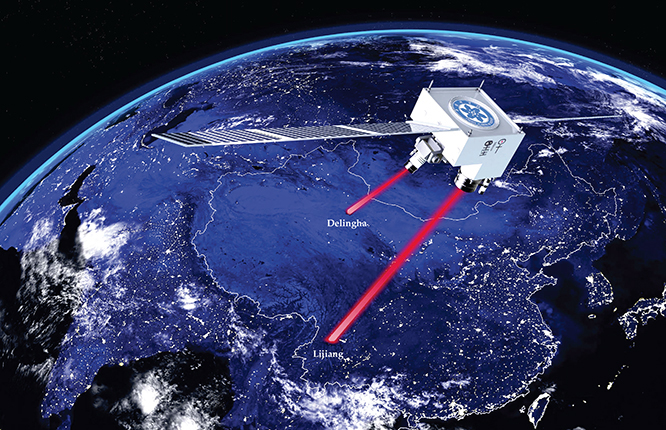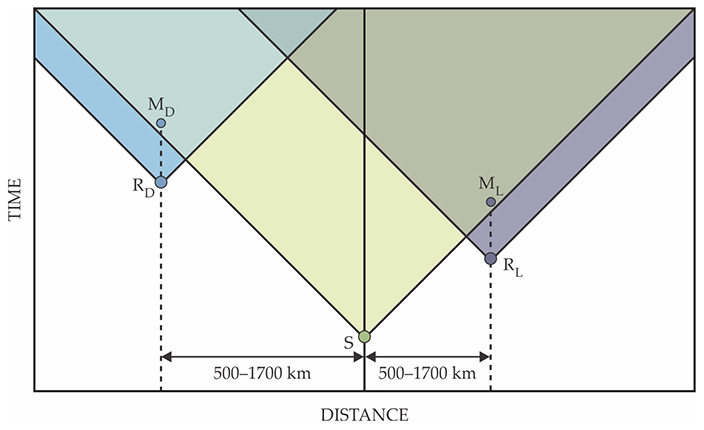Quantum entanglement reaches new heights
DOI: 10.1063/PT.3.3648
Jian-Wei Pan nearly wept as he watched a Long March rocket lift off from China’s Jiuquan Satellite Launch Center in the Gobi Desert in August 2016. The rocket carried the Quantum Science Satellite, which Pan and coworkers at the University of Science and Technology of China (USTC) had spent five years building and refining. He had spent twice that long lobbying to get the $100 million project funded. To see it finally off the ground, he says, “was truly a relief.”
The satellite, nicknamed Micius after the ancient Chinese philosopher, was to be the hub of an experimental quantum communications network. To start, it would take turns beaming pairs of polarization-entangled photons from its low-Earth, Sun-synchronous orbit to four ground stations throughout China (see figure
Figure 1.

The Quantum Science Satellite, nicknamed Micius, successfully beamed polarization-entangled photons from low-Earth orbit to two ground stations 1200 km apart in Delingha and Lijiang, China. Such satellite-based entanglement distribution could provide the basis for a highly secure quantum communications network. (Illustration courtesy of Jian-Wei Pan.)

Nothing in quantum mechanics limits the distance over which two photons can be entangled. But the farther they travel from each other, the more likely are their fragile quantum states to be disturbed by the environment along the way. When Pan began pondering a quantum network in the 1990s, entanglement had yet to be demonstrated beyond length scales of a few meters. To link cities and countries, it would have to be implemented at distances millions of times larger.
Now, a year after Micius’s launch, Pan and his coworkers report a milestone in their quest to build a quantum communications network: Micius has successfully distributed pairs of entangled photons between the Chinese cities of Delingha, on the Tibetan Plateau, and Lijiang, 1200 km to the south. 1 Never has the spooky action of quantum mechanics been observed at so great a distance.
“A crazy idea”
Micius has roots in work that Pan did as a graduate student two decades ago at the University of Innsbruck in Austria. There he, his adviser Anton Zeilinger, and their coworkers demonstrated a scheme for quantum teleportation: By measuring one of two entangled photons jointly with a third photon in an arbitrary quantum state, they could instantly project that state onto the other entangled photon. 2
Intrigued by the potential implications for quantum communication, both Pan and Zeilinger began thinking about ways to orchestrate long-distance entanglement. In 2001, when Pan took a faculty position at USTC in Hefei, he allocated half of his CNY2.4 million ($290 000) in startup funds to pursue satellite-based quantum communication. “People thought it was a crazy idea,” he recalls, “because it was already very challenging to do the sophisticated quantum optics experiments on a well-shielded optical table. How could you do them in space?”
Pan faced two main obstacles. One was the inherent difficulty of coherently transmitting photons over large distances. Although optical fibers can be used to distribute entangled photons between, say, distant buildings on a campus, 3 a photon would stand a negligible chance of surviving a trip longer than a few kilometers. Pan would instead beam light directly through the air. Inevitably, some photons are still lost to scattering and absorption. But if the beam and detector are well aligned, those losses are far smaller than in optical fibers.
In a 2005 ground test, Pan and coworkers successfully beamed entangled photons from the summit of Dashu Mountain to two sites more than 10 km apart in the city of Hefei below. 4 They later duplicated the feat over distances of 16 km along the Great Wall and 100 km across China’s Qinghai Lake. By 2012 the group was regularly distributing entanglement over distances greater than the 10 km effective thickness of Earth’s atmosphere. So was Zeilinger, who had been pursuing similar research in Austria. 5 There was little reason to doubt that entangled photons could survive a journey from space.
Generating the photons, however, was another matter. A common tactic is to use a nonlinear crystal to convert a pump photon into two photons of half the frequency—a process known as spontaneous parametric down conversion. If the phases and spatial modes of those photons overlap, the photons can become entangled.
The rates of entangled-pair generation tend to be low, but in ground tests Pan and his colleagues could compensate by pumping their crystal generously; at Qinghai Lake, they used a 1.3 W pump laser to generate 40 000 pairs of entangled photons per second. To produce a suitably bright photon beam using the limited power available on a satellite, they’d need a more efficient scheme.
The group ultimately adopted a strategy developed by Franco Wong’s group at MIT, in which the nonlinear crystal is placed inside an interferometer to improve the overlap of photons’ spatial modes and phases. 6 Pumped by a 30 mW laser, the source could generate nearly six million pairs of entangled photons per second. Moreover, the key ingredient, an interferometer known as a Sagnac loop, is insensitive to vibrational, thermal, and electromagnetic disturbances. In other words, it’s perfectly suited for the rigors of space travel.
The entangled web
Every night at around 1:30am local time, Micius hurtles into view of Delingha and then Lijiang. For roughly four and a half minutes, it’s visible from both cities. During that brief window, it sends polarization-entangled IR photons to the two sites’ ground receivers, 1 m telescopes coupled to single-photon detectors. A 100 kHz pulsed laser beam, emitted alongside the entangled photons, provides a time stamp: Tiny phase fluctuations known as jitter allow ground-based observers to determine whether two photons were emitted simultaneously. Red laser beacons emitted from each ground station and green ones emitted from the satellite help the satellite and receivers locate one another. The feedback-controlled system is so precise that the satellite’s aim is limited only by the diffraction of the photon beams, which broaden to spots 5–15 m in diameter by the time they reach the ground.
Due to diffraction, atmospheric scattering and absorption, and the occasional pointing error, only about one in six million photon pairs—or one pair per second—reaches both ground stations. Still, it took only four minutes of effective observation time for Pan and his coworkers to begin to see correlations among the photon pairs: A vertically polarized photon at one site almost always coincided with a horizontally polarized one at the other.
To show, however, that the photons were not merely correlated but quantum entangled, Pan and his colleagues had to perform what’s known as a Bell’s inequalities test. (See Physics Today, January 2016, page 14
Figure 2.

In a Bell test performed with detectors in Delingha and Lijiang, China, two polarization-entangled photons generated on a satellite at S travel 500–1700 km before being measured at MD and ML, respectively. Polarization measurement angles are chosen randomly at RD and RL, microseconds before the photons’ arrivals. Because RD and RL lie outside the light cone of S, information generated during the entanglement process can’t affect the choice of measurement angle. Because RD and MD lie outside the light cones of RL and ML and vice versa, the angle and outcome of one measurement can’t affect those of the other, except through the action of quantum entanglement. (Adapted from ref.

Under that protocol, Bell’s theorem predicts a quantitative difference between the correlations produced by quantum entanglement and those that can be produced by classical phenomena. After some 20 minutes of observation, spread over several nights, Pan and his colleagues could conclude with confidence that their correlations couldn’t possibly be classical.
The result completes the first of three experiments planned for Micius. Next, Pan and his colleagues hope to use the satellite to distribute encryption keys and, ultimately, perform quantum teleportation. They also plan to grow their fledgling network: In a collaboration involving Zeilinger, Micius may soon begin transmitting to a ground station in Vienna.
Stumbling blocks still litter the road to a practical quantum communications network. The current transmission rate of 1 bit per second is unrealistically small for most applications, and Pan and his colleagues will need to substantially improve their noise-filtering schemes if they hope to detect entangled photons during the daytime.
Still, Micius presents immediate opportunities to explore fundamental physics. Pan is particularly keen to probe interactions between quantum mechanics and gravity. “We’ve established a quantum optics laboratory with an effective lab space of a million square kilometers,” he says. “We can experiment at distances and velocities that were inaccessible on the ground.”
References
1. J. Yin et al., Science 356, 1140 (2017). https://doi.org/10.1126/science.aan3211
2. D. Bouwmeester et al., Nature 390, 575 (1997). https://doi.org/10.1038/37539
3. B. Hensen et al., Nature 526, 682 (2015). https://doi.org/10.1038/nature15759
4. C.-Z. Peng et al., Phys. Rev. Lett. 94, 150501 (2005). https://doi.org/10.1103/PhysRevLett.94.150501
5. X.-S. Ma et al., Nature 489, 269 (2012). https://doi.org/10.1038/nature11472
6. T. Kim, M. Fiorentino, F. Wong, Phys. Rev. A 73, 012316 (2006). https://doi.org/10.1103/PhysRevA.73.012316
